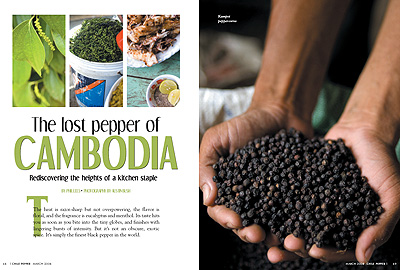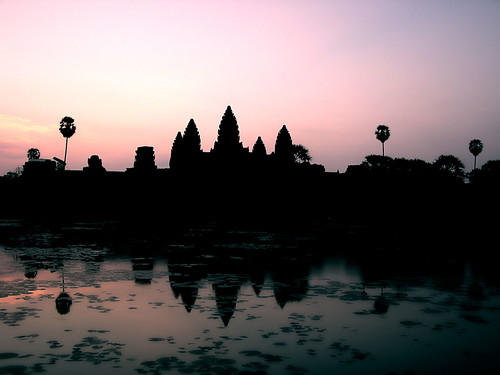Posts Tagged → Cambodian Food
Selling raw human misery to Quincy Jones
Originally sent: 22 November 2005.
My bizarre marketing task for the month has been deciding how to suitably horrify Quincy Jones.
For those of you playing at home, Quincy Jones is the all-time most nominated Grammy artist with a total of 77 nominations and 27 winning Grammys. He has won an Emmy and seven Oscars. He’s the man who wrote the Austin Powers Theme, made Will Smith famous on The Fresh Prince of Bel Air, and composed the world’s funkiest organ-driven title track for “They call me Mr. TIBBS!”. To top this off, he’s one of the few jazz musicians that I like from the bebop era that didn’t burn down their career in a blaze of heroin addiction. At the behest of UNICEF, SCC are taking him to experience as much raw human misery as he can stomach for two and a half hours to try and take a percentage of the profits that he made selling a hundred million Michael Jackson albums and Lesley Gore’s 1963 teen hit, “It’s My Party”.
The initial meeting with UNICEF to plan Quincy’s visit was strange in the extreme, partly because I was the only marketing person there and saw this purely as a sales exercise, partly because the whole group of us had become so inured to the suffering that we can use it comfortably as a marketing tool. Head UNICEF guy wanted us to show the visiting party a “range of Cambodian families” which after much discussion was decided that UNICEF wants us to display:
1) A family headed by someone with AIDS, dying in a dirt-floor shack;
2) A family where person from 1) has died, but family still supported;
3) A child-headed household/kids with AIDS.
We allotted 30 minutes per family.
I have a much more cynical trick up my sleeve because I’m the only person that knows who Quincy Jones is – and I like that marketing is a dirty sport. A few of the orphans and vulnerable children (known in the aid business as “OVC”) are learning Khmer traditional music at SCC’s pagoda in Siem Reap. When we throw some monks into the mix, surely that will make Quincy bleed cash.
As instant karmic penance for doing aid industry dirty work on behalf of monks, the next day I got hit by a Landcruiser while I was riding my bike on the way to the office. It’s much less serious than it sounds. I was stationary at a crossroads and the Landcruiser hit me from behind while it was trying to barge its way around the corner. I’m thankful that they didn’t stop and either try to extort some cash from me or shoot me for denting their car. I obviously look like the sort of person who can afford to buy whatever sort of retributive Cambodian justice I feel like.
M’s parents were here for three weeks: in between working, we did all the Cambodian provinces which aren’t too scary, too wet, or too poor to have anything at all in them. To fit in our travels, there are 6 public holidays in November: 3 consecutive days for Water Festival, 2 for Independence Day, 1 for the old King’s Birthday (Hail, Sihanouk!). By juggling my leave the right way, this month I will spend 8 days at work.
About a million Cambodians from the rural provinces come to Phnom Penh for Water Festival to pickpocket the rich white folk and serve as the butt of rural/urban divide humour. They were all at the Phnom Penh’s only mall when I went there, to see escalators and air-con for the first time. About half of the kids would jump on the escalator before their parent, so the parent – bewildered by the foreign mechanical stairs – would hold on to them. This resulted in momentum knocking them over and the oncoming stairs thoroughly shredding the children, while the Phnom Penh locals would revel in rural/urban divide humour that watching kids fall into a meat grinder creates. The vein of Cambodian physical comedy runs deep.
We missed everything for which the festival was famous: live appearances by the new King (Hail, Sihamoni!); dragon boat racing and the associated drownings; a million rural people using Hun Sen Park as a urinal. Instead we caught a taxi to Kampot, which has a rotting colonial cliff-top casino ghost town (Bokor); and Kep, which has the tastiest seafood in all Cambodia.
Bokor was where the French elite went to acclimatise to Indochina before the locals formed their own substitute for European colonial rule, and as they did with anything on a hill in Cambodia, turned it into a gun emplacement. Building Bokor casino would have had the same degree of difficulty as building a quaint French village by hand on top of one of the 12 Apostles using only an infinite amount of disposable Cambodian labour. Judging by the leftovers, beachside colonialism looked like it was a whole lot more fun and profitable than my postcolonial development junket.
Loc Lac Variation Spotting

Image via Serving Sake to a Serb
Loc Lac (as I’ve talked about before) is one of those dishes in Cambodia that has no authentic version but multitude variations – pretty much any dish which has a primary component of cubed, stir-fried beef fits the bill, which can be fried with anything insofar as it remains brownish.
Continue reading
Cambodian food reviewing: You’re doing it right.
It turns out that with only three months left in 2008, Cambodian is not the new Thai. But what has changed over the year is the tone of reviewing. Reviewers are starting to understand how to eat Cambodian food.
This week the NY Times revisits two Cambodian restaurants in New York. The results are mixed, but at least they’re eating well:
No meal in Cambodia is complete without soup, or samlor, and the versions found here are the real deal, a pitched battle between sour and sweet, whether teeming with turmeric (samlor mchoo kroeurng, $14.95) or chunky with tomato and pineapple (samlor mchoo moen, $13.95).
Maintaining the spider rage
Ten miles out of town, my guide pulls up at a little shack on a winding roadside. This is real boondocks Cambodia. Little kids are staring at me like they’ve never seen a white man before, which they probably haven’t.
From “Man bites frog”
I miss the days when I used to rant about the Cambodian spider story of the week, where a Western journalist, parachuted into a strange land, proceeds to take the local food completely out of context. It gave me a regular windmill to tilt at. Now when I pitch articles about the possibility of Cambodian food being a varied and delicate cuisine to magazines, I’m sure that the grim thought lurking in the back of every editor’s mind is “They eat spiders, don’t they”. Sean Thomas’ recent article in The Independent is a tour-de-force of the culinary racism that does me out of business.
What can you say about the decidedly unlovely tarantulas of Skuon? Except that they aren’t very lovely. Certainly, they are much prized in Cambodia – anyone who goes to Skuon is expected to bring back a bag of big roasted spiders for the kids. When told that these rancid, sugared arachnids are less than popular in the West, Cambodians are shocked and surprised. They find western cheese-eating equally repugnant, of course.
None of that is true apart from the spiders being manky. My Cambodian friends are cheese freaks. He finishes off by eating a dried frog in Phnom Penh, which is something that Cambodians don’t treat as food. Dried frog is for medicinal purposes and occasionally, a rice wine additive. Complaining about the way it tastes is a little like eating a few spoonfuls of straight cloves, then writing them off as useless as a foodstuff.
This is not to say that you can’t write about a food that you don’t know as a local: a perfect example of covering Cambodia well is Robyn and Dave from EatingAsia’s recent posts from Cambodia – they might not speak Khmer, but they can put the food into the context that they know well: similarities with Vietnamese and Isaan food; familiar herbs in an unfamiliar dish; photos that set the food in the real environment. It is a reminder that food is about tradition and memories, even if those traditions are not your own.
Props to Maytel for passing on the article.
The found pepper of Cambodia
What does the visit of Chinese emissary Zhou Daguan to Angkor Wat in 1297, Khmer Rouge kidnappings and the recent landgrabbing of Okhna Ly Yong Phat in rural Sre Ambel, Cambodia have in common?
Cambodian pepper: which is how I tenuously link them all together in this month’s Chile Pepper magazine (US). With photos from Austin Bush it promises the best collaboration since Snoop Dogg recorded “Ain’t Nuthin’ But A ‘G’ Thang” with Dr Dre.
Choul Chnam Thmei: Cambodian is the New Thai
While I’ve been saying for what seems like years that Sihanoukville is the new Luanda, in one of its final posts of the year, Epicurious has announced that for 2008, Cambodian food will supplant Thai food.
A triangulation between Vietnamese, Chinese, and Thai cooking, Cambodian’s emphasis on noodle dishes, curries, stir fries and prahok, the strong-flavored fish paste, will grow in popularity. Cambodian food has stronger flavors than Vietnamese, slightly more subtle that Thai and is not as heavy as Chinese.
Also, cheers to everyone who donated to Menu For Hope. Over US$90,000 was raised. Prize draw to come.
Cambodian food
If you’re looking for a more detailed look at Cambodian food, it’s worth checking out my Cambodian food blog, Phnomenon.com, which I wrote between 2005 and 2007 while living in Phnom Penh.

